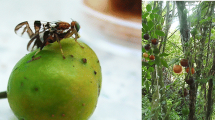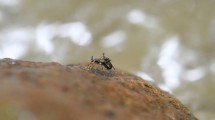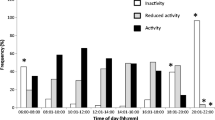Abstract
Precopulatory mate guarding behavior is a common strategy among males of many species. Although this behavior increases male reproductive success, it is also costly for males. In Veliidae (Insecta: Heteroptera), male mate guarding of immature females has been reported in three species with pronounced sexual dimorphism, particularly in the nymphal stage. We observed a similar behavior in Microvelia iriomotensis (Heteroptera: Veliidae), in which males and females are characterized by small differences in body size. In this study, we conducted choice tests to quantify the preference of male M. iriomotensis for virgin females more than 3 d after emerging (senior females), virgin females within 24 h of emergence (junior females), and fifth-instar nymphs. Males more often approached senior females, with 80% eventually selecting these females as mates. To determine whether males mount female nymphs in the absence of adult females, we placed single mature virgin males in plastic cups along with one fifth-instar female nymph, and found that 79.6% of males mounted the nymphs within 5 h. The findings of this study indicate that senior females are the most advantageous mating partners for males and that mating after maturity would present the least risk to females. Our results also indicate that adult males will mount female nymphs even in species without a biased sex ratio. This behavior of M. iriomotensis males may be associated with the early sexual maturity of females, which enables them to lay fertilized eggs soon after emerging.


Similar content being viewed by others
Data Availability Statement
The data supporting the findings of this study are available from the corresponding author on reasonable request.
References
Arakaki N, Kishita M, Nagayama A, Fukaya M, Yasui H, Akino T, Hirai Y, Wakamura S (2004) Precopulatory mate guarding by the male green chafer, Anomala albopilosa sakishimana Nomura (Coleoptera: Scarabaeidae). Appl Entomol Zool 39:455–462
Arnqvist G, Jones TM, Elgar MA (2003) Reversal of sex roles in nuptial feeding. Nature 424:387
Arnqvist G, Jones TM, Elgar MA (2007) The extraordinary mating system of Zeus bugs (Heteroptera: Veliidae: Phoreticovelia sp.). Aust J Zool 55:131–137
Biaggio MD, Sandomirsky I, Lubin Y, Harari AR, Andrade MCB (2016) Copulation with immature females increases male fitness in cannibalistic widow spiders. Biol Lett 12:20160516
Birkhead TR, Clarkson K (1980) Mate selection and precopulatory guarding in Gammarus pulex. Z Tierpsychol 52:365–380
Fairbairn DJ (1993) Costs of loading associated with mate-carrying in the waterstrider, Aquarius remigis. Behav Ecol 4:224–231
Jackson RR (1986) Cohabitation of males and juvenile females: A prevalent mating tactic of spiders. J Nat Hist 20:1193–1210
Jarrige A, Kassis A, Schmoll T, Goubault M (2016) Recently mated males of a lek-mating insect intensify precopulatory mate guarding under male competition. Anim Behav 117:21–34
Jones TM, Elgar MA, Arnqvist G (2010) Extreme cost of male riding behaviour for juvenile females of the Zeus bug. Anim Behav 79:11–16
Jormalainen V (1998) Precopulatory mate guarding in crustaceans: male competitive strategy and intersexual conflict. Q Rev Biol 73:275–304
Kuramitsu K, Yooboon T, Tomatsuri M, Yamada H, Yokoi T (2019) First come, first served: precopulatory mate-guarding behavior and male-male contests by a hymenopteran saproxylic parasitoid. Sci Nat 106:23
Lambert DM, Slooten E (1983) Evolutionary studies of the New Zealand coastal mosquito Opifex fuscus (Hutton) I. Mating Behaviour. Behaviour 84:157–171
Manning JT (1975) Male discrimination and investments in Asellus aquaticus (L.) and A. meridianus Racovitsza (Crustacea: Isopoda). Behaviour 55:1–14
Matsushima R, Ohba S, Yokoi T (2021) Oviposition and refractory periods of the small water strider Microvelia horvathi (Heteroptera: Veliidae) after a single mating event. Entomol Sci 24:27–31
Miller AK, Miller PL, Siva-Jothy MT (1984) Precopulatory guarding and other aspects of reproductive behaviour in Sympetrum depressiusculum (Selys) at rice fields in southern France (Anisoptera: Libellulidae). Odonatologica 13:407–414
Miyamoto S (1953) Biology of Microvelia diluta Distant, with descriptions of its brachypterous form and larval stages. Sieboldia 1:113–133 (pls. 15–18)
Parker GA (1974) Courtship persistence and female-guarding as male time investment strategies. Behaviour 48:157–183
Potter DA, Wrensch DL, Johnston DE (1976) Guarding, aggressive behavior, and mating success in male twospotted spider mites. Ann Entomol Soc Am 69:707–711
R Core Team (2020) R: A Language and Environment for Statistical Computing. R Foundation for Statistical Computing, Vienna, Austria. https://www.r-project.org/. Accessed 4 Mar 2021
Rowe L (1994) The costs of mating and mate choice in water striders. Anim Behav 48:1049–1056
Sato H, Hiramatsu K (1993) Mating behaviour and sexual selection in the African ball-rolling scarab Khepher platynotus (Bates) (Coleoptera: Scarabaeidae). J Nat Hist 27:657–668
Siva-Jothy MT (1984) Sperm competition in the family Libellulidae (Anisoptera) with special reference to Crocothemis erythraea (Brulle) and Orthetrum cancellatum (L.). Adv Odonatol 2:195–207
Sparkes TC, Keogh DP, Pary RA (1996) Energetic costs of mate guarding behavior in male stream-dwelling isopods. Oecologia 106:166–171
Venables WN, Ripley BD (2002) Modern applied statistics with S, 4th edn. Springer, New York
Waage JK (1979) Dual function of the damselfly penis: Sperm removal and transfer. Science 203:916–918
Yokoi N (1990) The sperm removal behavior of the yellow spotted longicorn beetle Psacothea hilaris (Coleoptera: Cerambycidae). Appl Entomol Zool 25:383–388
Acknowledgements
We express our sincere gratitude to Masaya Kato (Okinawa Environment and Regional Consultant) for collecting the samples, the staff of the Ishikawa Insect Museum for cooperation during this study, and Editage (www.editage.jp) for English language editing.
Author information
Authors and Affiliations
Contributions
Project design: Kohei Watanabe and Ryosuke Matsushima. Data collection: Kohei Watanabe and Hirokazu Fukutomi. Rearing: Kohei Watanabe and Hirokazu Fukutomi. Data analysis: Ryosuke Matsushima. Manuscript writing: Kohei Watanabe and Ryosuke Matsushima. All authors have read the final manuscript and have agreed to its publication.
Corresponding author
Ethics declarations
Research Involving Human Participants and/or Animals
Not applicable.
Informed Consent
Not applicable.
Competing interests
The authors declare no competing interests.
Disclosure of Potential Conflicts of Interest
There are no conflicts of interest to declare.
Additional information
Publisher's Note
Springer Nature remains neutral with regard to jurisdictional claims in published maps and institutional affiliations.
Supplementary Information
Below is the link to the electronic supplementary material.


Movie S1 A male Microvelia iriomotensis that failed to mount. This male was unaware that the female nymph had emerged and continued to mount the exuvium of the emerged female (MP4 19669 kb)
Movie S2 A male Microvelia iriomotensis that succeeded in mounting a new female adult after emerging (MP4 21201 kb)
Rights and permissions
Springer Nature or its licensor (e.g. a society or other partner) holds exclusive rights to this article under a publishing agreement with the author(s) or other rightsholder(s); author self-archiving of the accepted manuscript version of this article is solely governed by the terms of such publishing agreement and applicable law.
About this article
Cite this article
Watanabe, K., Fukutomi, H. & Matsushima, R. Male Mating Strategy and Preference for Females of Different Maturity Stages in the Small Water Strider, Microvelia iriomotensis (Heteroptera: Veliidae). J Insect Behav 36, 45–51 (2023). https://doi.org/10.1007/s10905-023-09818-7
Received:
Revised:
Accepted:
Published:
Issue Date:
DOI: https://doi.org/10.1007/s10905-023-09818-7




